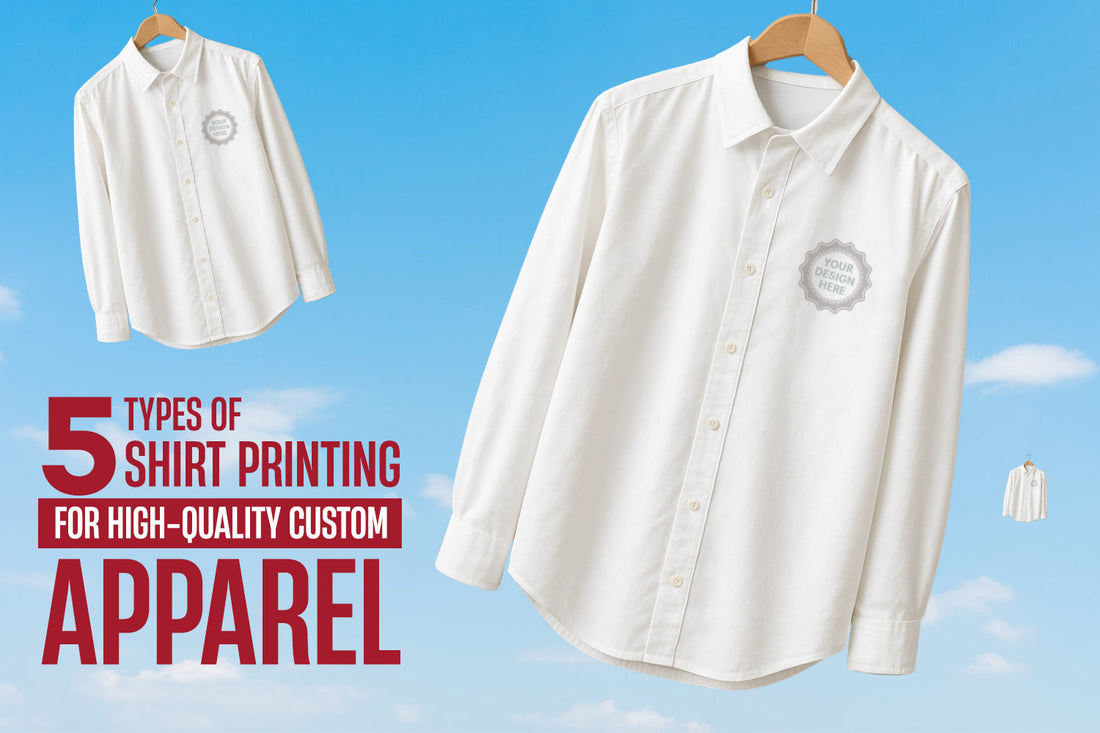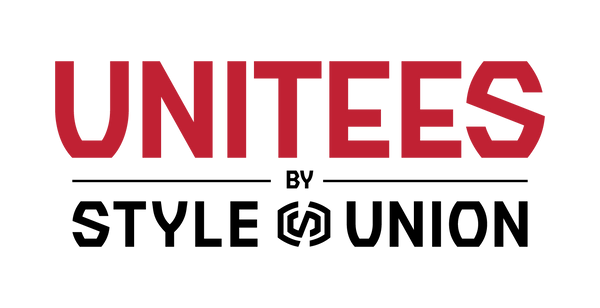
5 Types of Shirt Printing for High-Quality Custom Apparel
A sharp shirt catches attention. But what holds that attention is often the print. Whether it's a crisp logo over the chest, a clean monogram on the cuff, or a bold statement across the back, the way a design is printed on a shirt speaks volumes about its purpose and quality.
From corporate uniforms to event wear, the right printing technique turns a simple shirt into branded apparel. But not all printing methods deliver the same results on structured fabrics. Unlike lightweight tees, formal and collared shirts demand more control over ink absorption, design alignment, and fabric compatibility.
Before you commission your next batch of branded shirts, it helps to understand the various types of shirt printing used in the apparel industry. Each method has its strengths depending on the shirt material, design detail, volume, and wearability.
In this guide, we’ll break down five professional-grade printing methods that combine durability, precision, and visual appeal for custom shirts designed to last.
1. Screen Printing
Screen printing is one of the most widely used techniques in the apparel industry, especially for large batch production. It involves creating a stencil (or screen) for each color in the design and pressing ink through the screen directly onto the fabric. The result is a vibrant, solid print that stands out sharply on the shirt surface.
For structured shirts like cotton formals or button-downs, screen printing works exceptionally well when the design is bold and doesn’t require intricate detailing. Logos, taglines, and geometric patterns look clean and last long with this method. The ink sits on top of the fabric, making the print visually prominent without soaking into the material.
Ideal Use
- Company uniforms
- Promotional button-up shirts
- Shirts for colleges, campaigns, or teams
Strengths
- Highly durable, even after multiple washes
- Best suited for high-volume orders
-
Cost-effective when printing the same design across large quantities
Things to Keep in Mind
- Not ideal for photo-like gradients or small text
- Requires separate screens for each color, so multicolor designs can increase costs
- Works best on 100 percent cotton or poly-cotton blends
Screen printing is often chosen for its balance of quality, speed, and cost. When done correctly, it creates a consistent look across dozens or hundreds of shirts, perfect for maintaining brand uniformity.
2. Heat Transfer Printing
Heat transfer printing uses heat and pressure to apply a printed design from a special transfer paper onto the shirt. The design is first printed using a heat-sensitive ink and then pressed onto the fabric using a heat press machine. This method allows for detailed, full-color images with smooth finishes.
On structured shirts, such as poly-cotton dress shirts or semi-casual wear, heat transfer is useful for sharp and photo-realistic visuals. It also offers flexibility for short-run or customized prints without setup costs for screens or plates.
Ideal Use
- Short runs with varying names or numbers
- Marketing campaigns or giveaways
- Shirts with high-resolution images or complex gradients
Strengths
- Can replicate detailed, multi-color designs easil
- Allows on-demand customization
-
Suitable for low to medium quantity orders
Things to Keep in Mind
- Not as breathable as screen prints due to film-like finish
- May peel or fade over time if not properly applied
-
Best used on lighter fabrics for clean image transfer
Heat transfer printing is especially popular for custom shirts, where individual details like names, departments, or slogans differ from piece to piece. It’s a go-to method for brands that need flexibility with lower production volume.
3. Embroidery
Embroidery involves stitching a design directly into the fabric using thread, often with the help of computerized machines. Unlike ink-based methods, embroidery adds texture and a premium look to the final product. It is a top choice for formal or high-end apparel where a refined, long-lasting appearance is essential.
On button-downs, office wear, or semi formal shirts, embroidery stands out as a subtle yet powerful branding technique. It is commonly used to showcase company logos on the chest or sleeves and is especially effective for uniforms where durability and professionalism matter.
Ideal Use
- Corporate dress shirts
- Staff uniforms for hospitality or retail
- Gifted formalwear or branded merchandise
Strengths
- Long-lasting and fade-resistant
- Adds a textured, professional look
- Ideal for small logos, monograms, and emblems
Things to Keep in Mind
- Not suitable for large or detailed designs
- Limited color blending compared to print methods
- Can be slightly rigid on thin or stretchy fabrics
Embroidery works best when you need the branding to last through repeated wear and washing without losing its appeal. While it's more expensive than print options, it offers unmatched elegance and durability, making it a favorite for executive-level apparel and brand representation.
4. Direct to Garment (DTG) Printing
Direct to Garment (DTG) printing is a relatively modern method that works like an inkjet printer for fabric. The design is printed directly onto the shirt using specialized water-based inks that soak into the fibers. It produces detailed, full-color prints without the need for screens or transfers.
While DTG printing is commonly associated with t-shirts, it can also be used on shirts with smooth, flat surfaces. For brands that need short runs with photo-quality detail, this method provides impressive results with minimal setup time.
Ideal Use
- Fashion-forward brands with artistic designs
- Shirts with gradient or photo-based artwork
- Limited-edition pieces or sample collections
Strengths
- High-resolution, full-color prints
- Perfect for one-off or short-run projects
- Soft finish that blends into the fabric
Things to Keep in Mind
- Works best on 100 percent cotton fabrics
- Not ideal for dark-colored shirts without pre-treatment
- Slower than screen printing for large volumes
DTG printing is especially useful when launching a new design, running a pilot collection, or printing visually rich images where every detail counts. For businesses seeking flexibility and visual impact without committing to large batches, DTG offers a practical and efficient solution.
5. Sublimation Printing
Sublimation printing is a process that uses heat to transfer dye onto fabric. It differs from other printing techniques by turning the dye into gas and bonding it directly with the fabric fibers. The result is a vibrant, long-lasting design that becomes part of the material itself, not just a layer on top.
While sublimation is not suitable for cotton shirts, it excels on polyester or polyester-blend shirts with a light base color. This method is ideal for creative branding or full-coverage prints where the design extends beyond standard chest placement.
Ideal Use
- Branded performance shirts
- Uniforms with all-over prints
- Fully customized design projects
Strengths
- Ink becomes part of the fabric, so no cracking or peeling
- Extremely durable even after frequent washing
- Excellent for full-surface or edge-to-edge designs
Things to Keep in Mind
- Only works on polyester or synthetic-blend fabrics
- Requires light-colored fabric for accurate print results
- Not suitable for traditional cotton shirts
Sublimation is often used for custom personalized shirts where brands want to go beyond standard placements and create bold, full-coverage apparel. It offers endless creative potential and ensures your design stays vibrant and intact no matter how often the shirt is worn or washed.
Conclusion
Choosing the right printing method for shirts is not just a design decision, it is a strategic one. The material, purpose, quantity, and visual expectations all play a role in determining which technique delivers the best result. Whether you are looking for clean branding, durable finishes, or vibrant full-color prints, each method brings its own strengths to the table.
Screen printing is ideal for bold, large-scale production. Heat transfer offers flexibility for short runs and on-demand customization. Embroidery delivers a premium and professional finish that stands the test of time. DTG printing excels in detail-rich designs with soft finishes, while sublimation brings full-coverage creativity to polyester fabrics.
Understanding these differences helps businesses, event organizers, and brand managers make confident decisions before committing to bulk printing. The right method not only enhances the shirt’s visual appeal but also improves wearability, longevity, and the overall brand experience.
Before your next apparel order, consider not just what you want your shirts to say but how you want them to say it.
